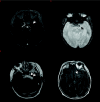Diagnostic and prognostic value of early MR Imaging vessel signs in hyperacute stroke patients imaged <3 hours and treated with recombinant tissue plasminogen activator
- PMID: 15764589
- PMCID: PMC7976462
Diagnostic and prognostic value of early MR Imaging vessel signs in hyperacute stroke patients imaged <3 hours and treated with recombinant tissue plasminogen activator
Abstract
Background and purpose: Analogous to the CT hyperattenuated vessel sign (HMCAS), MR imaging may show hypo- or hyperintense vessels in acute ischemic stroke (AIS) patients. We assessed the diagnostic and prognostic strength of early MR imaging vessel signs in AIS patients treated with intravenous thrombolysis (IVT) within 3 hours of the onset of symptoms.
Methods: We studied AIS patients both treated with IVT and stroke MR imaged within 3 hours of the onset of symptoms and at 2 hours and 24 hours after treatment. We assessed the presence or absence of early vessel signs (hyperintense fluid-attenuated inversion recovery sign [FLAIR HVS]; gradient-echo susceptibility vessel sign [GRE SVS]) compared with a combined MR angiography/perfusion-weighted imaging reference and their strength for predicting clinical outcome (favorable vs. poor, independent vs. dependent, or dead, death), recanalization (by clot composition and flow), and hemorrhage in uni- and multivariate analysis.
Results: Fifty-six patients (age range, 76 years +/- 13 years; median National Institutes of Health stroke scale score [NIHSSS], 11) met the inclusion criteria. Forty-four patients (78.6%) had a vessel occlusion at baseline; 22 of them (50%) recanalized. Nineteen patients (33.9%) suffered some form of intracranial hemorrhage (ICH), 24 patients (42.9%) had an independent outcome, 18 patients (32.1%) a favorable outcome, and 14 patients died. Compared with our combined reference for vessel status PWI/MRA, the sensitivities of CT HMCAS, FLAIR HVS, and GRE SVS were 40%, 66%, and 34%, respectively, and improved during the hours that followed. Localization was accurately reflected by FLAIR HVS but not by GRE SVS. Only NIHSSS and age were independent predictors for recanalization and all clinical outcomes in multiple logistic regression analysis.
Conclusion: Although early vessel signs can be helpful in the diagnosis of intravascular disease, they do not independently predict recanalization, ICH, or any of the three clinical outcomes in a multivariate logistic regression model. Thrombus composition as reflected by signal intensity characteristics on GRE and FLAIR does not predict the therapeutic effect of IVT.
Figures

Comment in
-
Location, location, location: angiography discerns early MR imaging vessel signs due to proximal arterial occlusion and distal collateral flow.AJNR Am J Neuroradiol. 2005 Oct;26(9):2432-3; author reply 2433-4. AJNR Am J Neuroradiol. 2005. PMID: 16219865 Free PMC article. No abstract available.
Similar articles
-
Monitoring intravenous recombinant tissue plasminogen activator thrombolysis for acute ischemic stroke with diffusion and perfusion MRI.Stroke. 2000 Jun;31(6):1318-28. doi: 10.1161/01.str.31.6.1318. Stroke. 2000. PMID: 10835451
-
Baseline magnetic resonance imaging parameters and stroke outcome in patients treated by intravenous tissue plasminogen activator.Stroke. 2003 Feb;34(2):458-63. doi: 10.1161/01.str.0000053850.64877.af. Stroke. 2003. PMID: 12574560 Clinical Trial.
-
Importance of cerebral artery recanalization in patients with stroke with and without neurological improvement after intravenous thrombolysis.Stroke. 2013 Sep;44(9):2513-8. doi: 10.1161/STROKEAHA.111.000048. Epub 2013 Jul 23. Stroke. 2013. PMID: 23881960
-
Susceptibility vessel sign as a predictor for recanalization and clinical outcome in acute ischaemic stroke: A systematic review and meta-analysis.J Clin Neurosci. 2021 Dec;94:159-165. doi: 10.1016/j.jocn.2021.10.017. Epub 2021 Oct 26. J Clin Neurosci. 2021. PMID: 34863431
-
Fluid-attenuated inversion recovery vascular hyperintensities: an important imaging marker for cerebrovascular disease.AJNR Am J Neuroradiol. 2011 Nov-Dec;32(10):1771-5. doi: 10.3174/ajnr.A2265. Epub 2010 Nov 4. AJNR Am J Neuroradiol. 2011. PMID: 21051516 Free PMC article. Review.
Cited by
-
Fluid-Attenuated Inversion Recovery Vascular Hyperintensity Topography, Novel Imaging Marker for Revascularization in Middle Cerebral Artery Occlusion.Stroke. 2016 Nov;47(11):2763-2769. doi: 10.1161/STROKEAHA.116.013953. Epub 2016 Sep 22. Stroke. 2016. PMID: 27659851 Free PMC article.
-
Susceptibility vessel sign predicts poor clinical outcome for acute stroke patients untreated by thrombolysis.Exp Ther Med. 2017 Nov;14(5):5207-5213. doi: 10.3892/etm.2017.5195. Epub 2017 Sep 22. Exp Ther Med. 2017. PMID: 29201238 Free PMC article.
-
Fluid-attenuated inversion recovery vascular hyperintensity-diffusion-weighted imaging mismatch and functional outcome after endovascular reperfusion therapy for acute ischemic stroke.Interv Neuroradiol. 2024 Apr;30(2):189-194. doi: 10.1177/15910199221113900. Epub 2022 Jul 29. Interv Neuroradiol. 2024. PMID: 35903941 Free PMC article.
-
Distal hyperintense vessels on FLAIR images predict large-artery stenosis in patients with transient ischemic attack.Neuroradiology. 2013 Feb;55(2):165-9. doi: 10.1007/s00234-012-1092-y. Epub 2012 Sep 23. Neuroradiology. 2013. PMID: 23001486
-
Location, location, location: angiography discerns early MR imaging vessel signs due to proximal arterial occlusion and distal collateral flow.AJNR Am J Neuroradiol. 2005 Oct;26(9):2432-3; author reply 2433-4. AJNR Am J Neuroradiol. 2005. PMID: 16219865 Free PMC article. No abstract available.
References
-
- The National Institute of Neurological Disorders and Stroke rt-PA Stroke Study Group. Tissue plasminogen activator for acute ischemic stroke. N Engl J Med 1995;333:1581–1587 - PubMed
-
- Warach S. Measurement of the ischemic penumbra with MRI: it’s about time. Stroke 2003;34:2533–2534 - PubMed
-
- Schellinger PD, Fiebach JB, Hacke W. Imaging-based decision making in thrombolytic therapy for ischemic stroke: present status. Stroke 2003;34:575–583 - PubMed
-
- Pressman BD, Tourje EJ, Thompson JR. An early CT sign of ischemic infarction: increased density in a cerebral artery. AJR Am J Roentgenol 1987;149:583–586 - PubMed
Publication types
MeSH terms
Substances
LinkOut - more resources
Full Text Sources
Medical
Miscellaneous
